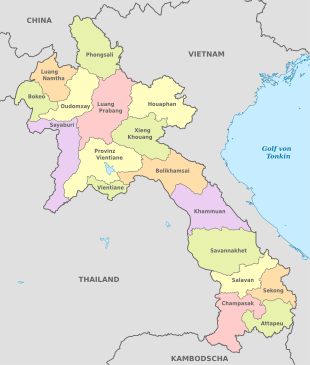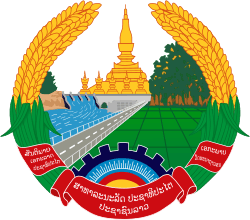Sex trafficking in Laos
Sex trafficking in Laos is human trafficking for the purpose of sexual exploitation and slavery that occurs in the Lao People's Democratic Republic. Laos is primarily an origin country for sexually trafficked persons.[1]
Sex trafficking victims in the country are from all ethnic groups in Laos and foreigners. Laos citizens, primarily women and girls, have been sex trafficked into other countries in Asia and different continents. They are threatened[2] and forced into prostitution, marriages, and or pregnancies.[3][4] Sex trafficked victims experience physically and psychologically trauma.[2] They contract sexually transmitted diseases from rapes,[5] and abuse and malnutrition are prevalent.[5] Some women and girls are tortured and or murdered.[3]
Sex trafficking and exploitation is pervasive throughout all levels of Laos society. Male and female perpetrators in Laos come from diverse backgrounds. A number of traffickers are members of or facilitated by gangs.[3]
The extent of sex trafficking in Laos is unknown because of the lack data, the concealed nature of sex trafficking crimes, and other factors. Anti-sex trafficking efforts have been hindered by corruption, indifference, border management problems, and more.[6][4]
Victims

Laos women and girls are sex trafficked into Thailand,[3] Vietnam, China,[7] Taiwan, Japan,[8] and other countries throughout the world. They are forced into marriages or brothels[4] and karaoke bars,[5] and unfree labour in homes or on farms. Many are tied or locked up and harmed.[3][6] A number of traumatized victims have nightmares. Rescued victims do not receive adequate rehabilitation services.[6] They experience stigma.[9] Some have been re-trafficked because of the lack of protection.[3]
Women and girls from families in poverty and lack education, as well as children,[2] are vulnerable to sex trafficking.[6] People from minority groups are also susceptible.[7]
Perpetrators
The traffickers are often part of gangs.[3] The perpetrators are sometimes the victims' family members or acquaintances.[6]
Anti-sex trafficking efforts
The government has made some efforts to stop sex trafficking, but these are insufficient.[6] Resources are scarce.[7]
Corruption
Corruption and impunity have hampered Laos's response in reducing sex trafficking. Some officials and police have facilitated the trafficking of women and girls and or are on the perpetrators' payroll.[6] Authorities accept bribes and commit document forgery and fraud.[4]
Government response problems
The Laos government has been criticized for its anti-sex trafficking efforts. Some police have been negligent. Long-term support for victims is inadequate.[6]
Non-governmental organizations
Village Focus International (VFI) carries out anti-sex trafficking initiatives in Laos.[10]
References
- "LAO PDR UN ACT". UN ACT.
- "Two teenagers rescued from forced prostitution in Laos". Thanh Nien News. November 4, 2014.
- "Trafficking Racket Smashed". Radio Free Asia. October 14, 2010.
- "Chinese marriage proposals become prostitution nightmares for some Lao girls". Radio Free Asia. February 13, 2017.
- "Lao girl's escape leads to arrest of sex trafficking suspect". Bangkok Post.
- "Sex Trafficking Victims Go Unnoticed in Laos". The Diplomat. March 26, 2014.
- "Hundreds of Laotian women "sold" in China, victims of human trafficking". Asia News. May 19, 2012.
- "USAID LAOS COUNTER TRAFFICKING IN PERSONS (USAID LAOS CTIP)". USAID. 28 November 2018.
- "Farm training the key to helping Laos human trafficking survivors". ABC News. March 7, 2018.
- "Minneapolis Lao-American fights human trafficking in Laos". Minn Post. August 9, 2013.
